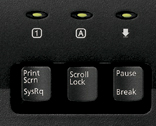What is a Jumbo Frame and why should you enable it when they will go fragmented over the Internet? First of all, in small local 1G networks it has quite a good impact on performance. Especially on multimedia over IP. And Second – it’s quite good on file transfer too. It takes less overhead and more real payload when Jumbo frames are enabled even on your own local home network (I have 7.5 PCs in my home. One behind the TV. One holds the internet connection and protects the others. One holds all my files with a Samba sharing. Other keeps live backup of my blog. One heavy game PC. One Linux sand-box for experiments. One UMPC. And one Android smartphone.) So it will not affect performance if both my TV PC plays a movie directly from the Samba and I am uploading a backup of my Blog, while a uTorrent session on the game PC is downloading the files over the Samba. All 3 in parallel.
Good enough?
First of all. You must have Jumbo frames enabled in Kernel. Second. You must check if your NIC is high MTU capable (MTU = Max Transfer Unit) with ifconfig. If it’s unable, you will see error message. I have a 4 NIC PC for experiments with old classic RTL8139 chip. They don’t do the job at all:
bash-4.1# lspci | grep [Ee]ther 01:01.0 Ethernet controller: Realtek Semiconductor Co., Ltd. RTL-8139/8139C/8139C+ (rev 10) 01:02.0 Ethernet controller: Realtek Semiconductor Co., Ltd. RTL-8139/8139C/8139C+ (rev 10) 01:03.0 Ethernet controller: Realtek Semiconductor Co., Ltd. RTL-8139/8139C/8139C+ (rev 10) 01:04.0 Ethernet controller: Realtek Semiconductor Co., Ltd. RTL-8139/8139C/8139C+ (rev 10) bash-4.1# ifconfig eth3 mtu 512 bash-4.1# ifconfig eth3 mtu 4000 SIOCSIFMTU: Invalid argument bash-4.1# ifconfig eth3 mtu 9000 SIOCSIFMTU: Invalid argument bash-4.1#
Not going to help me at all. So I switch to the more potent machine on my work desk.
root@router:~# lspci | grep [Ee]ther 0c:00.0 Ethernet controller: D-Link System Inc Gigabit Ethernet Adapter (rev 11) 0c:01.0 Ethernet controller: D-Link System Inc Gigabit Ethernet Adapter (rev 11) root@router:~#
For this test I am using one Telco Systems network unit in the Laboratory where I work to generate traffic of 5 Mbits/s over a linux bridged connection. Obviously, the bridged connection over the Lab PC is not allowing Jumbo frames. PDU sizes of 2000 and 9000 bytes, do not pass.
---------------------------------------------------------------- | Size | Successful rate | Net Successful rate | Frame-loss | +--------+-----------------+---------------------+-------------+ | 64 | 5000Kbps | 3809Kbps | 0.000 % | | 128 | 5000Kbps | 4324Kbps | 0.000 % | | 256 | 5000Kbps | 4637Kbps | 0.000 % | | 512 | 5000Kbps | 4812Kbps | 0.000 % | | 1024 | 5000Kbps | 4904Kbps | 0.000 % | | 1280 | 5000Kbps | 4923Kbps | 0.000 % | | 1518 | 5000Kbps | 4934Kbps | 0.000 % | | 2000 | 0Kbps | 0Kbps | 100.000 % | | 9000 | 0Kbps | 0Kbps | 100.000 % | +--------+-----------------+---------------------+-------------+ ---------------------------------------------------------------- | Size | Min Delay | Avg Delay | Max Delay | +--------+-----------------+-----------------+-----------------+ | 64 | 77.312 us | 79.037 us | 166.400 us | | 128 | 102.912 us | 104.884 us | 255.488 us | | 256 | 154.624 us | 156.385 us | 197.632 us | | 512 | 249.856 us | 251.178 us | 501.248 us | | 1024 | 432.128 us | 433.554 us | 444.416 us | | 1280 | 523.264 us | 524.655 us | 649.728 us | | 1518 | 607.744 us | 609.398 us | 635.904 us | | 2000 | 0.000 us | 0.000 us | 0.000 us | | 9000 | 0.000 us | 0.000 us | 0.000 us | +--------+-----------------+-----------------+-----------------+
And this is what happened when I issued the commands
ifconfig eth0 mtu 9000 ifconfig eth1 mtu 9000 ... ... ---------------------------------------------------------------- | Size | Successful rate | Net Successful rate | Frame-loss | +--------+-----------------+---------------------+-------------+ | 64 | 5000Kbps | 3809Kbps | 0.000 % | | 128 | 5000Kbps | 4324Kbps | 0.000 % | | 256 | 5000Kbps | 4637Kbps | 0.000 % | | 512 | 5000Kbps | 4812Kbps | 0.000 % | | 1024 | 5000Kbps | 4904Kbps | 0.000 % | | 1280 | 5000Kbps | 4923Kbps | 0.000 % | | 1518 | 5000Kbps | 4934Kbps | 0.147 % | | 2000 | 5000Kbps | 4950Kbps | 0.000 % | | 9000 | 5000Kbps | 4988Kbps | 0.000 % | +--------+-----------------+---------------------+-------------+ ---------------------------------------------------------------- | Size | Min Delay | Avg Delay | Max Delay | +--------+-----------------+-----------------+-----------------+ | 64 | 14.336 us | 14.401 us | 14.848 us | | 128 | 15.872 us | 16.723 us | 17.408 us | | 256 | 19.456 us | 20.703 us | 22.016 us | | 512 | 28.672 us | 28.686 us | 29.184 us | | 1024 | 43.520 us | 44.229 us | 44.544 us | | 1280 | 51.712 us | 52.437 us | 53.248 us | | 1518 | 58.880 us | 59.927 us | 60.928 us | | 2000 | 74.240 us | 74.844 us | 75.264 us | | 9000 | 293.888 us | 294.365 us | 294.912 us | +--------+-----------------+-----------------+-----------------+
So It actually works, but not with my cheap NICs in home. The RTL family is quite good, but the good models with faster chip are a bit expensive for my home networks. If you want the MTU set on startup, there are 2 ways. First one, you add lines like this in /etc/rc.d/rc.inet1.conf:
# Config information for eth0: IPADDR[0]="172.16.1.1" NETMASK[0]="255.255.255.0" USE_DHCP[0]="" DHCP_HOSTNAME[1]="" MTU[0]="9000" # Config information for eth1: IPADDR[1]="10.1.1.1" NETMASK[1]="255.255.255.0" USE_DHCP[1]="" DHCP_HOSTNAME[1]="" MTU[1]="9000"
Anyone giving away his “old” gigabit cards? 😉
